 Climate Action funding is available for a range of tenders, relating to the geological storage of CO2, security measures used by the financial sector, the optimal development of rural policy, EU strategies for climate change adaptation and policy development and assessment in relation to climate change. Funding is worth up to €230,000 over 36 months for CO2 storage proposals, up to €250,000 over six months for financial sector studies, up to €400,000 over 12 months for rural projects, up to €700,000 over 15 months for climate change adaptation and up to €2.5 million over 12 months for climate policy actions.
Climate Action funding is available for a range of tenders, relating to the geological storage of CO2, security measures used by the financial sector, the optimal development of rural policy, EU strategies for climate change adaptation and policy development and assessment in relation to climate change. Funding is worth up to €230,000 over 36 months for CO2 storage proposals, up to €250,000 over six months for financial sector studies, up to €400,000 over 12 months for rural projects, up to €700,000 over 15 months for climate change adaptation and up to €2.5 million over 12 months for climate policy actions.
Monthly Archives / June 2011
Prof Rudy Gozlan – ‘A Fish Tale, World Preservation and You’
Last month Rudy Gozlan gave an inaugural lecture as part of BU’s Public Lecture series. He discussed the biggest issue in ecology right now – how we going to accommodate another 3 billion people on this planet in the next 40 years. Watch Rudy’s lecture (‘A Fish Tale, world preservation and you’) on this subject here: httpv://youtu.be/kK3IsaZ2FYc
EU funding for water, energy and land use statistics
 Eurostat invites proposals for a range of tenders exploring statistics in relation to water use in developing countries, agro-agricultural land use, national statistical systems and energy. Funding is worth up to €100,000 over 12 months for water statistics projects, €10.7 million over 21 months for land use projects and €75,000 over 12 months for NSS research. For energy research up to €300,000 over 12 months is available, divided into three contracts, or up to €270,000 over 30 months, divided into three contracts, depending on the lot selected. View the full details for these calls by performing a Funding Search for 1162932, 1162933, 1162934 or 1162955 in the Full Text field.
Eurostat invites proposals for a range of tenders exploring statistics in relation to water use in developing countries, agro-agricultural land use, national statistical systems and energy. Funding is worth up to €100,000 over 12 months for water statistics projects, €10.7 million over 21 months for land use projects and €75,000 over 12 months for NSS research. For energy research up to €300,000 over 12 months is available, divided into three contracts, or up to €270,000 over 30 months, divided into three contracts, depending on the lot selected. View the full details for these calls by performing a Funding Search for 1162932, 1162933, 1162934 or 1162955 in the Full Text field.
The Public Value of the Humanities
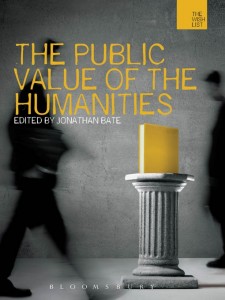 Demonstrating the public value of research will be a significant part of the forthcoming REF exercise. Most major funding bodies now require an impact statement as part of the application process. Universities are being required to demonstrate that their research offers value for money and tangible benefits outside of the academic sphere. This is easier in some disciplines than others, with many people believing the arts, humanities and social sciences (AHSS) will struggle to demonstrate impact.
Demonstrating the public value of research will be a significant part of the forthcoming REF exercise. Most major funding bodies now require an impact statement as part of the application process. Universities are being required to demonstrate that their research offers value for money and tangible benefits outside of the academic sphere. This is easier in some disciplines than others, with many people believing the arts, humanities and social sciences (AHSS) will struggle to demonstrate impact.
The Public Value of the Humanities, recently published by Bloombury Academic and edited by Prof Jonathan Bate (University of Warwick), demonstrates how the AHSS discplines can demonstrate that their research has public impact, benefit and value.
For a full review of the book see the review on the THE website.
You can buy this book on Amazon.
Funding available for EU sustainable development indicators & audiovisual production and statistics
 Eurostat has funding available for two topics:
Eurostat has funding available for two topics:
Tenders submitted under ‘Publications and an audiovisual production on European Union sustainable development indicators‘ should review the knowledge relating to this field in the EU by carrying out conceptual work and analyses and drawing up a draft manual as a citizens’ guide to assessing sustainable development. Funding is worth up to €200,000 over six months and the deadline is 28.07.11.
Tenders submitted under EU Statistics should focus on income and living conditions methodological studies and publications; statistics on high-tec industries, knowledge-based services and human resources in science and tehcnology; statistics on innovation; patent statistics, with a focus on patenting by SMEs; methodological development of statistics on crime and criminal justice. The overall budget for this call is €1.75 million over 36 months and the deadline is 28.07.11.
Excellent BU Research Highlighted in New Report

Big Ideas for the Future
Thursday’s theme is Big Ideas for the Future and a research project being undertaken by Prof Alan Fyall and Dr Heather Hartwell has been highlighted in a new report out today. The report produced by Research Councils UK (RCUK) and Universities UK (UUK) called Big Ideas for the Future looks at 100 ground breaking pieces of research from all fields, including science, social sciences, engineering, and the arts and the humanities, that is taking place in UK higher education at the moment and what it will mean for us in 20 years time. The report is narrated and backed by high-profile celebrity academics such as Professor Lord Robert Winston, Dr Alice Roberts and Professor Iain Stewart.

The BU research team are exploring the relationship of co-locating a tourism and public health strategy, in particular examining the positioning of seaside towns in Southern England. The Big Ideas for the Future Submission prepared by the team and containing more information on the research is available by clicking the link.
BU research reported in Times Higher Education today
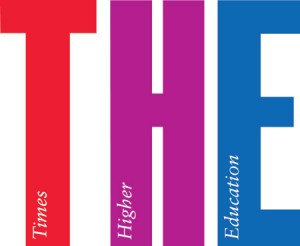 The BU research-based film we previously reported on has been highlighted today by Times Higher Education UK. Rufus Stone is part of the New Dynamics of Ageing programme and will tell the story of being gay and growing older in the British countryside. Using research findings in this way is a great way of engaging the public, creating and impact and raising the overall profile of BU. Shooting should begin in mid-July so we will have to wait to see the final result but congratularuons again to Kip Jones and the rest of the team involved.
The BU research-based film we previously reported on has been highlighted today by Times Higher Education UK. Rufus Stone is part of the New Dynamics of Ageing programme and will tell the story of being gay and growing older in the British countryside. Using research findings in this way is a great way of engaging the public, creating and impact and raising the overall profile of BU. Shooting should begin in mid-July so we will have to wait to see the final result but congratularuons again to Kip Jones and the rest of the team involved.
UK academics accused of demanding too much office space: discuss!
 The Estate Management Statistics annual report has found that academics in the UK have more office space than people working in other sectors and it will take a “cultural change” to make them use their space more efficiently. The report says that office-space norms in the UK higher education sector are “completely at odds” with those in other sectors and that there is significant of scope for rationalisation. The report also states that while other sectors have moved from the concept of private offices to shared spaces, some academics still view having their own office as the “norm for their discipline and method of teaching, and perhaps a status symbol”. The EMS recommends institutions make departments more accountable for use of space by charging them for it. What do you think about this?
The Estate Management Statistics annual report has found that academics in the UK have more office space than people working in other sectors and it will take a “cultural change” to make them use their space more efficiently. The report says that office-space norms in the UK higher education sector are “completely at odds” with those in other sectors and that there is significant of scope for rationalisation. The report also states that while other sectors have moved from the concept of private offices to shared spaces, some academics still view having their own office as the “norm for their discipline and method of teaching, and perhaps a status symbol”. The EMS recommends institutions make departments more accountable for use of space by charging them for it. What do you think about this?
Population and patient data sharing for mental health research funding available
 The MRC invites proposals for a population and patient data sharing initiative for research into mental health. Projects should exploit high-quality existing data in novel ways to advance knowledge of factors affecting addiction and mental illness and inform research for new treatments. A total budget of £1 million is available; see the MRC website for more details.
The MRC invites proposals for a population and patient data sharing initiative for research into mental health. Projects should exploit high-quality existing data in novel ways to advance knowledge of factors affecting addiction and mental illness and inform research for new treatments. A total budget of £1 million is available; see the MRC website for more details.
Universities need public-private funds to boost innovation, says Committee of the Regions
According to president of the Committee of the Regions Mercedes Bresso in the  , universities are drivers of regional development and innovation, and should be encouraged to set up partnerships with businesses through joint public and private innovation funds and in addition to using Structural Funds for regional development more strategically, loans, venture capital and credits should be more easily accessible to small companies to boost technology transfer.
, universities are drivers of regional development and innovation, and should be encouraged to set up partnerships with businesses through joint public and private innovation funds and in addition to using Structural Funds for regional development more strategically, loans, venture capital and credits should be more easily accessible to small companies to boost technology transfer.
New BU Blog poll is published
 Many thanks to everyone who voted in the first BU Research Blog poll! This was on whether journal impact factors are a good indicator of quality. Anita will write a future blog post on the results.
Many thanks to everyone who voted in the first BU Research Blog poll! This was on whether journal impact factors are a good indicator of quality. Anita will write a future blog post on the results.
We’ve now issued the second poll which you should be able to see on the right hand side of the Blog homepage, alongside the Quick Links. The second poll focuses on academic support for specific research activities (such as writing proposals, managing grants, etc) and asks which you’d appreciate more support with.
Please do take the time (it honestly only takes a couple of seconds) to respond as this will shape the support offered to academics in future 🙂
Research Themes – Culture and Society meeting
Universities Week – Big Ideas for Society
 This week is Universities Week 2011, a national campaign demonstrating the benefits of universities within UK society! Today focuses on universities’ historical contribution to the big society, long before this phrase became commonly used. Thriving university towns and cities will be highlighted by demonstrating how universities give back to the local and national community.
This week is Universities Week 2011, a national campaign demonstrating the benefits of universities within UK society! Today focuses on universities’ historical contribution to the big society, long before this phrase became commonly used. Thriving university towns and cities will be highlighted by demonstrating how universities give back to the local and national community.
A new report out today shows the social impact of universities is worth over £1.31 billion in the form of health and wellbeing, citizenship and political engagement, and that universities benefit everyone not just those who go to university to study. The report, published by leading independent thinktank nef and Universities UK (Degrees of Value: How universities benefit society) attempts for the first time to put a monetary value on some of the ways that universities contribute to society at a local and a national level, using Social Return on Investment (SROI) methodology. These values are above and beyond the economic contribution that universities make.
BU makes a significant contribution to society through many initiatives, such as:
- sponsoring St Aldhelms Academy in Poole
- providing volunteering opportunities for staff and students via The Hub
- exercise classes, sports facilities, tournaments, children’s summer camps, etc, offered by SportBU
- citizenship days for local school children are run by the Centre for Global Perspectives
- the Atrium Art Gallery showcases work by local and national artists, offers free entry and is open to the public
You can read the full report here.
Leisure and Recreation (Sean Beer and Scott Cohen)
Author: Sean Beer and Scott Cohen (Tourism)
Alternative name suggestion: Recreation and leisure
Brief theme summary: We view leisure and recreation as an interdisciplinary theme that closely engages associated subjects of tourism, sport, health, events, retail and hospitality, as well as the arts, outdoor pursuits, play and entertainment, amongst others. Central to understandings of leisure is its association with non-work time and work/life balances, although admittedly the boundaries between leisure and work often blur.
Experience is central to leisure and recreation, in which people may seek to enhance the quality of their lives through leisure’s potential to transform, refresh, recreate, relax and/or escape. Leisure and recreation link to the renewal and development of social bonds, social capital, forms of cultural consumption, creativity and self-development, through both formal and informal modes and at home and away from home.
Leisure and recreation is also concerned with issues of social inclusion, equity and diversity through policy and practice, as well as socio-cultural and environmental research in relation to its impacts.
Also drawing together notions of hospitable space and the formation of some types of temporary events, leisure and recreation can thus be seen as encompassing a full range of practices associated with the meanings, processes and activities that may enrich non-work time and space.
Scope of theme: what is included? Leisure, recreation, leisure/work balance, tourism, hospitality, events, retail, sport, health and healthy living, physical activity, exercise, play, gaming, experience, entertainment, casual/serious leisure, art, culture, creativity, learning, consumption, pro-sumption, lifestyle, volunteering, adventure, local/global, physical/virtual, transport, movement/mobility, social/cultural/environmental/economic aspects of leisure, fusion.
Scope of theme: what is excluded? For discussion of this please see section on Links with other BU themes under consideration.
Which big societal questions are addressed by this theme?
- Quality of life: mental, physical, spiritual
- The Big Society: the relationship between the public, private and third sectors and society, responsibility and individual behaviour within society with regard to many of the big issues of the day such as climate change, health, sustainability
- Work life balance: the blurring of the edges between work and leisure
- Equality and access (Gender, age, disability, sexual orientation, wealth, family units)
- Aging population (A particular issue for the UK and the SW of England.)
- Multiculturalism
- Localism and globalisation
- The growth of the virtual world
How do these link to the priorities of the major funding bodies?
- Arts and Humanities Research Council, numerous opportunities
- Economic and Social Research Council, all areas of their strategic priorities; Influencing Behaviour and Informing Interventions, A Vibrant and Fair Society, Economic Performance and Sustainable Growth.
- Leverhulme, broad, but for example, particularly focussing on surmounting traditional disciplinary academic boundaries
- British Academy, a wide range of opportunities
- Nuffield Foundation, many opportunities
- Esmée Fairbairn Foundation, opportunities for funded research which helps them in their aim to improve the quality of life for people and communities in the UK both now and in the future
- Natural Environment Research Council, links between leisure, the natural environment and sustainability
- Engineering and Physical Sciences Research Council, areas such as technology and behaviour interventions.
- Biotechnology and Biological Sciences Research Council, areas such as food and sustainability.
- Medical Research Council, collaborative work through programme grant scheme
- European Union, potential under FP7 and in other areas
Research Excellence Framework Unit of Assessment 26 & 19 (and also others though the emphasis would be more towards the theme of the other Unit.)
How does this theme interlink with the other BU themes currently under consideration? There are a multitude of connections to the other themes. This is not seen as a disadvantage, we deliberately set out to be inclusive and holistic in our approach rather than exclusive and reductionist. The approach is underpinned by an intention to look for fruitful areas of collaboration and to be able to showcase the work of colleagues in a variety of ways.
Thus within Health and wellbeing there are overlaps in terms of quality of life, social inclusion and involvement in volunteering, for instance, but not necessarily in relation to management of health care and health care professionals. In terms of Environmental change and biodiversity and the Green economy and sustainability the natural environment and human wellbeing are intrinsically linked, as are concepts of sustainability and the action of the individual through volunteering for an environmental charity for example. The science of biodiversity is not an area that comes within the theme.
There are synergies with regard to work looking at Aging, relating to access and quality of life, but not directly with specific therapies. For many people learning is leisure, though work based learning is not. There are connections with Learning and public engagement, as there are with Entrepreneurship and economic growth, given the role of individuals outside work in things like social entrepreneurship and also entrepreneurship within specific leisure and recreation industries.
For many individuals leisure and recreation is bound up with Technology and design as well as the Creative and digital economies, and whilst this theme is not connected to the intricacies of web design (unless it is your hobby) increasingly people are conducting their leisure lives in virtual worlds, where social connections and connecting is a virtual experience of life, love and even sex, but who is to say that it is any better or worse for that. All this seems to be underpinned by change and any consideration of Culture and society or Society & Social Change must be a close bed fellow to this and all the other themes.
Writing a lay summary is easy, right?

 Not necessarily! The lay summary is an extremely important part of most research bids. Most researchers think they write it well, and yet many bids fail because it is not ‘lay enough’. The topic was debated at this year’s ARMA conference (Association of Research Managers and Administrators) in bonnie Glasgow. The highlights of the session are detailed below.
Not necessarily! The lay summary is an extremely important part of most research bids. Most researchers think they write it well, and yet many bids fail because it is not ‘lay enough’. The topic was debated at this year’s ARMA conference (Association of Research Managers and Administrators) in bonnie Glasgow. The highlights of the session are detailed below.
A lay summary is used to explain complex ideas and technical and scientific terms to people who do not have a prior knowledge about the subject. A lay audience is heterogeneous (it includes the general public, patients and users of the science, politicians and other decision-makers, and researchers in different disciplines such as potential research collaborators). A lay summary is a requirement at application stage by most funding bodies, including the UK research councils.
When applying to UK research councils you are normally allowed up to 4,000 characters for your lay summary. There is no need to use all of these characters; often being concise is good for a lay audience! There are also some funding bodies that enforce a much stricter word limit, such as the British Heart Foundation who only allow up to 100 words for a lay summary.
What is the definition and purpose of a lay summary?
This very much depends on which funding body you are applying to as they all have their own definitions. For example, the Je-S Help Guide states the summary should be “written so that it will be understood by a non-specialist audience” but each of the different research councils have their own definition, such as:
EPSRC – “Using simple terms you are asked to describe your proposed research in a way that can be publicised to a general audience. It is very important that you make every effort to ensure that your summary is understandable to someone who is not an expert in your field. This is the section of your application that, if successful, EPSRC will use for publicity purposes. You should also note that the Outline panels who will review your proposal will be drawn from across EPSRC’s remit and will not necessarily have expertise in your research area.”
ESRC – “Write in plain English. Your proposal is likely to be seen by a great many people, some of whom will not be versed in your particular specialisation. Detail and specification may necessitate the use of disciplinary or technical terminology and this will be clear to peer reviewers, but the ideas you wish to convey and your reasons for doing so should be apparent to a wide audience. By the same token, do take the trouble to check spelling, grammar and punctuation. These are all part of the quality of presentation and presentation matters!
What is the story you are telling?
What is the audience?
Why does it matter?
Why now?
Why are they the best person to carry out this research?”
One of the most concise and succinct definitions is provided by Buckland et al (2007): “a brief summary of a research project or a research proposal that has been written for members of the public rather than researchers or professionals. It should be written in plain English, avoid the use of jargon and explain any technical terms that have been included”. [1]
These different definitions are very confusing! But in essence a lay summary has three main requirements:
- To paint the bigger picture
- To answer who, what, where, when, why, how?
- Be written in plain English
 Painting the bigger picture: The lay summary is your first chance to impress the reviewer! Reviewers are very busy and in the majority of cases the lay summary is the first (and sometimes the only) part of a grant application that he/she will read. It is therefore vitally important that it is interesting, easy to read and conscise. It needs to give an overview of the whole project – the background, aims and expected impact.
Painting the bigger picture: The lay summary is your first chance to impress the reviewer! Reviewers are very busy and in the majority of cases the lay summary is the first (and sometimes the only) part of a grant application that he/she will read. It is therefore vitally important that it is interesting, easy to read and conscise. It needs to give an overview of the whole project – the background, aims and expected impact.
Answer who, what, where, when, why, how?: It may sound harsh but many reviewers will read research proposals and be left asking themselves ‘so what?’. Your lay summary needs to answer this by explaining why the project is exciting, relevant and timely, and worth funding now above all of the other submitted proposals. Lay summaries are normally used by funding bodies to promote the research project so think about who is likely to read your lay summary, should your proposal be funded, and ensure you answer these ‘who, what, where, when, why and how’ questions with these various readers in mind. For example, your lay summary may be used in the following ways:
- by politicians in raising and justifying research funds from government;
- to justify public spending on research;
- to attract new collaborators such as industrial partners and researchers from different disciplines
- by press officers to promote your research to the public
 Be written in plain English: A strong lay summary will always explain any technical terms used, spell out abbreviations, and avoid using jargon. It will also be written in ‘plain English’ but what exactly does this mean?
Be written in plain English: A strong lay summary will always explain any technical terms used, spell out abbreviations, and avoid using jargon. It will also be written in ‘plain English’ but what exactly does this mean?
- Titles should be simple and clear. The European Commission’s FP7 guidance states that titles should be understandable to the non-specialist in the field. The best format for a title is to give a short statement followed by a colon and then a brief explanation.
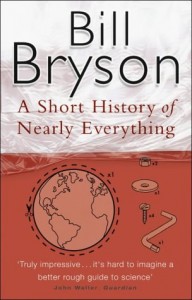 Simple analogies should be used to help the reader make sense of complex ideas. Arthritis Research UK suggest a good example of this is Bill Bryson’s book ‘A Short History of Nearly Everything’ [2] which uses analogies of everyday objects and activities to explain complex scientific concepts. Whilst simple analogies might mean that you lose detail and may not be perfect then strengthen your proposal if they make your ideas clearer to the reader.
Simple analogies should be used to help the reader make sense of complex ideas. Arthritis Research UK suggest a good example of this is Bill Bryson’s book ‘A Short History of Nearly Everything’ [2] which uses analogies of everyday objects and activities to explain complex scientific concepts. Whilst simple analogies might mean that you lose detail and may not be perfect then strengthen your proposal if they make your ideas clearer to the reader.- Clear layout – avoid using English phrases (such as ‘the lion’s share’) as these may not be understood by the reader. Avoid using double negatives as they cloud meaning. Order the paragraphs logically – start with the problem your research aims to solve so the reader can identify with this first. Break up blocks of text with bullet points, shorter paragraphs, etc. It is good practice to match the layout with the layout of your objectives. Do not use jargon (unless it is defined and explained in the summary) and ensure all abbreviations are spelt out.
Media / public engagement training courses: The UK research councils offer media/public communications training courses. These are highly recommended within the sector and offer good value for money. Most councils allow you to include the costs in your research proposal providing you justify it in your case for support, otherwise the training is free to funded students or grant holders. For example:
- EPSRC – http://www.epsrc.ac.uk/funding/grants/pe/Pages/commstraining.aspx
- BBSRC – http://www.bbsrc.ac.uk/funding/awardholders/media-training.aspx
- ESRC – http://www.esrc.ac.uk/funding-and-guidance/tools-and-resources/impact-toolkit/tools/media/media-training.aspx
- NERC – http://www.nerc.ac.uk/press/mediatraining.asp
BU’s internal peer review scheme (RPRS): Support for writing and strengthening research proposals (including writing a good lay summary) is available via the internal Research Proposal Review Service (RPRS). Visit the RPRS webpage for further information!
References:
[1] Buckland, S. et al (2007) Public Information Pack. How to get actively involved in NHS, public health and social care research. INVOLVE Public Information Pack 4 available at: http://www.invo.org.uk/pdfs/pip44jargonbuster.pdf
[2] Bryson, B (2004) A Short History of Nearly Everything, Black Swan: London
The advantages of winning EU funding: BU’s Sherry Jeary shares her experiences

“I spent the first three months of this year sitting in REC, a software engineering company in Wroclaw, Poland doing  the job of a Software Engineer. So what is unusual about that? I am a Senior Lecturer in Software Engineering and have, for the first time in my career, had complete immersion in a company doing the subject I research, talk to students about, enthuse with colleagues about and generally bore my outside friends about. As part of the INFER project headed up by Bogdan Gabrys which is creating a complex, predictive, adaptive system, I have had an opportunity that rarely comes an academics way. I got to live in Wroclaw, had fun getting about in a beautiful part of Poland and really enjoyed being among the Polish people. ( I would also recommend the Bison grass Vodka J).
the job of a Software Engineer. So what is unusual about that? I am a Senior Lecturer in Software Engineering and have, for the first time in my career, had complete immersion in a company doing the subject I research, talk to students about, enthuse with colleagues about and generally bore my outside friends about. As part of the INFER project headed up by Bogdan Gabrys which is creating a complex, predictive, adaptive system, I have had an opportunity that rarely comes an academics way. I got to live in Wroclaw, had fun getting about in a beautiful part of Poland and really enjoyed being among the Polish people. ( I would also recommend the Bison grass Vodka J).
As a result I have already written a conference paper and had it accepted whilst a journal paper will follow. I will have two very useful case studies which I can discuss with colleagues and have learnt a great deal about the processes involved in the company (my particular research interest). I am advising the company on the ways that they can improve what they are doing – so it is a two way thing. Finally, as a result of the project my network  has expanded considerably with both academics and industrialists. I can see how I may need change my teaching strategy to respond to what is happening in the real world and I am well placed to consider applying for funding with my company colleagues in the future to continue the work I have started.
has expanded considerably with both academics and industrialists. I can see how I may need change my teaching strategy to respond to what is happening in the real world and I am well placed to consider applying for funding with my company colleagues in the future to continue the work I have started.
At a recent meeting discussing our strategy for BU’s engagement with Europe, I was surprised to hear that many academics were either not interested or were nervous of starting out in the EU. I agreed to write about my current journey. If you work at BU and want to find out more, let me know. I am happy to help.”
Engaging Academic Social Scientists in Government Policy-Making and Delivery
 Prof Martin Kretschmer, Professor of Information Jurisprudence and Research Centre Director for CIPPM in the Business School, recently attended a meeting organised by the British Academy and the ESRC on Engaging Academic Social Scientists in Government Policy-Making and Delivery. Here he provides an overview of the issues discussed at the event…
Prof Martin Kretschmer, Professor of Information Jurisprudence and Research Centre Director for CIPPM in the Business School, recently attended a meeting organised by the British Academy and the ESRC on Engaging Academic Social Scientists in Government Policy-Making and Delivery. Here he provides an overview of the issues discussed at the event…
Making research relevant to policy is on the agenda of all Research Councils, as reflected in the Impact measure of REF 2014. The event was co-sponsored by the Government Heads of the Analytical Professions: Government Economic Service, Government Operational Research Service, Government Science & Engineering, Social Science in Government, and the Government Statistical Service. The programme and list of attendees is available here: British Academy event programme and delegate list
Some of the issues raised, and questions asked of the attendees included:
Q1: What do you think government should be doing more of to increase the influence of your research and expertise on government policy making and delivery?
Q2: What do you think the academic social science community should be doing more of to have a direct influence on government policy making and delivery?
Q3: What might encourage you to consider an advisory role to government, for example, as a social scientist on one of the government’s Scientific Advisory Committees?
 I assume I was invited because I am just coming to the end of an ESRC Public Sector Fellowship in the UK Intellectual Property Office (within BIS). I also sit on the government’s Copyright Advisory Expert Group, and speak frequently on policy issues, for example last week (1 June) at a Hearing in the European Parliament on The Future of Copyright in the Digital Era.
I assume I was invited because I am just coming to the end of an ESRC Public Sector Fellowship in the UK Intellectual Property Office (within BIS). I also sit on the government’s Copyright Advisory Expert Group, and speak frequently on policy issues, for example last week (1 June) at a Hearing in the European Parliament on The Future of Copyright in the Digital Era.
Below, I summarise a few points from the meeting that may be useful for the wider BU research community.
Prof Nick Pidgeon (Professor of Environmental Psychology, University of Cardiff, and Director of the Understanding Risk Research Group) offered 4 routes to influencing government:
- Government contract research, including small review contracts.
- RCUK (or similar) funding in policy relevant area.
- Advisory Committees.
- Indirectly, via dissemination through Royal Society, RSA, or similar.
Paul Johnson (Director of the Institute for Fiscal Studies): “Don’t expect to change government policy if your evidence points in a different direction.” There are two choices: EITHER Focus on points of detail within the policy direction given by government, OR Set agenda for 5 years hence.
Sir John Beddington (Government Chief Scientific Advisor) stressed the tightrope walk between advice that is a “challenge” and being labelled “unhelpful” (in Sir Humphries language). Academics should risk “challenge” even if it turns out to be “unhelpful”.
Prof Philip Lowe (Professor of Rural Economy, University of Newcastle, and Director of the Rural Economy and Land Use Programme): There is a paradox – How can a government department become a sophisticated consumer of research? Commissioning good research requires being able to know what you don’t know. Hard for civil servants and politicians. Important to build and sustains links over many years.
Prof Helen Roberts (Professor, General Adolescent and Paediatrics Unit, University College London, and non-executive director of the National Institute for Health and Clinical Excellence NICE): Public sector placements are very useful, both for academic and government, but governance of these grants can be cumbersome. [I can confirm that from my own secondment experience. At some point, there were suggestions that detailed delivery contracts would have to be drawn up between ESRC and BU, ESRC and BIS/IPO, BIS/IPO and BU. In the end, I was simply shown the Official Secrets Act, and the Code of Conduct for Civil Servants, and that was it.]
Importance of human dimension: “Most implementation comes though good relationships, not good research.”
Sharon Witherspoon (Deputy Director of the Nuffield Foundation, and in charge of research in social science and social policy): Most policy advisors double in “empirically informed counterfactuals”, and are normally grateful if offered help with: “What would happen if…” But academics can often make the most telling contribution by more radical reflection: “I wouldn’t start from here”. Governments are less likely to be open to that kind of challenge. Select Committees are becoming more independent of government (now have elected chairs). They can be a route to influence.
Paul Doyle (CEO, ESRC): The ESRC is building a database of government policy leads/contacts. Often it is impossible from government websites to identify the civil servants and special advisors dealing with specific policy issues. Government scientists should be encouraged to become members of Learned Societies.
Key points from the open discussion:
- Importance to keep independence by constructing portfolio of funders.
- Economists are a separate breed in government. They have little concept of wider social research.
- Responding to consultations is often a good first step to engagement.
- Academics should use less jargon, shorter sentences.
- Visual representation of research findings matters greatly.
- Often it is useful to invite policy makers to academic events. They enjoy coming out of the office, and are less partisan/circumspect in a neutral environment.
- There is an important corrective function for social scientists in assessing the presentation of data.
- Difficulty in presenting the audit trail required for REF Impact. Government does have no interest in revealing the sources of its ideas, or it may be politically inconvenient to do so.
Universities Week – Big Ideas for Business
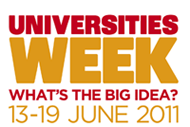 This week is Universities Week 2011, a national campaign demonstrating the benefits of universities within UK society! Today focuses on the growing relationship between small or mid-size businesses and universities.
This week is Universities Week 2011, a national campaign demonstrating the benefits of universities within UK society! Today focuses on the growing relationship between small or mid-size businesses and universities.
Universities and businesses collaborate in thousands of partnerships throughout the country. These relationships help to boost the local economy throughout the UK.
Universities support start-up organizations through tailored programs, as clients, and as suppliers of their local workforce.
As part of Universities Week a report has been published by Universities UK that shows that universities can increase the success of small businesses, drive innovation and employment, and boost the local economy. You can read the full report here.
BU works in partnership with many businesses exchanging ideas and knowledge. You can read more, including case studies, on our BU Business Services website.












 New Nepal scoping review on maternal & neonatal health
New Nepal scoping review on maternal & neonatal health Fourth INRC Symposium: From Clinical Applications to Neuro-Inspired Computation
Fourth INRC Symposium: From Clinical Applications to Neuro-Inspired Computation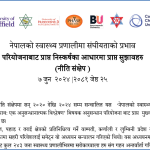 Writing policy briefs
Writing policy briefs Upholding Excellence: The Concordat to Support Research Integrity
Upholding Excellence: The Concordat to Support Research Integrity ECR Funding Open Call: Research Culture & Community Grant – Application Deadline Friday 12 December
ECR Funding Open Call: Research Culture & Community Grant – Application Deadline Friday 12 December MSCA Postdoctoral Fellowships 2025 Call
MSCA Postdoctoral Fellowships 2025 Call ERC Advanced Grant 2025 Webinar
ERC Advanced Grant 2025 Webinar Horizon Europe Work Programme 2025 Published
Horizon Europe Work Programme 2025 Published Horizon Europe 2025 Work Programme pre-Published
Horizon Europe 2025 Work Programme pre-Published Update on UKRO services
Update on UKRO services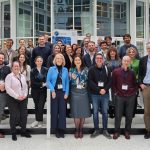 European research project exploring use of ‘virtual twins’ to better manage metabolic associated fatty liver disease
European research project exploring use of ‘virtual twins’ to better manage metabolic associated fatty liver disease